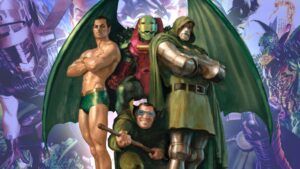
The Fantastic Four, Marvel’s First Family, have long been at the forefront of superhero storytelling, pushing the boundaries of comic book narratives with their blend of adventure, family dynamics, and cosmic intrigue. From their first appearance in Fantastic Four #1 (1961), the team—Reed Richards, Sue Storm, Johnny Storm, and Ben Grimm—quickly established themselves as the pillars of the Marvel Universe. Their adventures, often filled with larger-than-life battles against world-ending threats, have captured the imaginations of readers for decades.
In the first article of this blog series, Marvel’s First Family: The Origins and Rise of the Fantastic Four, we explored the formation of the team and their early adventures. From the tragic accident that gave them their powers to their first encounters with some of Marvel’s most dangerous foes, the origin story set the stage for an expansive universe of challenges, both personal and cosmic.
While the team’s growth and legacy are crucial to their appeal, their villains play an equally important role in shaping their narrative and character arcs. The battles against these adversaries have tested the limits of the team’s unity and their resolve. Whether facing personal betrayals, cosmic threats, or ideological challenges, the villains of the Fantastic Four embody much of what Marvel’s larger themes—idealism, reality, and overconfidence—stand for.
As we dive into this exploration of their greatest foes, we’ll look not only at their most iconic adversaries but also at the deeper philosophical undercurrents in the battles that defined the Fantastic Four’s evolution.
Doctor Doom: The Tragic Genius Driven by Ambition and Loss
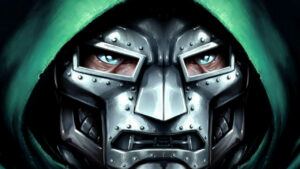
No discussion of the Fantastic Four’s villains is complete without Victor Von Doom, better known as Doctor Doom. First appearing in Fantastic Four #5 (1962), Doom quickly established himself as one of Marvel’s most iconic villains. His blend of brilliance, ambition, and tragic humanity make him a deeply complex character. Doom’s intellectual superiority, combined with his ruthless drive for power, leads him into constant conflict with the Fantastic Four, particularly Reed Richards. While his pursuit of world domination often makes him seem like a traditional villain, his motivations are driven by loss, revenge, and a desperate need to control his destiny. Over time, Doctor Doom has become a character of immense depth, with his actions often posing important philosophical questions about the limits of ambition, the nature of control, and the cost of absolute power.
Historical Context
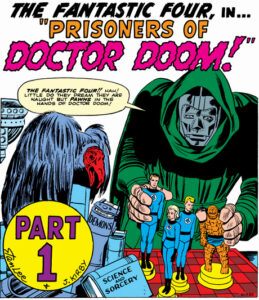 First appearance in Fantastic Four #5 (Fantastic Four #5, July 1962, written by Stan Lee, art by Jack Kirby): Doctor Doom’s first appearance in Fantastic Four #5 immediately set the stage for his rivalry with Reed Richards and established him as one of Marvel’s most formidable and tragic adversaries. With his genius intellect, unyielding will, and tragic past, Doom quickly rose to prominence as a key villain in the Marvel Universe.
First appearance in Fantastic Four #5 (Fantastic Four #5, July 1962, written by Stan Lee, art by Jack Kirby): Doctor Doom’s first appearance in Fantastic Four #5 immediately set the stage for his rivalry with Reed Richards and established him as one of Marvel’s most formidable and tragic adversaries. With his genius intellect, unyielding will, and tragic past, Doom quickly rose to prominence as a key villain in the Marvel Universe.
Key Storylines
- This Man… This Monster! (Fantastic Four #51, March 1966, written by Stan Lee, art by Jack Kirby): One of Doom’s most memorable appearances, this storyline delves into his rivalry with Reed Richards, emphasizing the differences between Reed’s sense of responsibility and Doom’s unchecked ambition. In this issue, Doom’s intellectual arrogance leads to a clash with Reed, illustrating the dangerous consequences of pursuing power without understanding the human cost. This issue is a poignant exploration of the theme of overconfidence, showcasing Doom’s tragic inability to recognize the humanity in others.
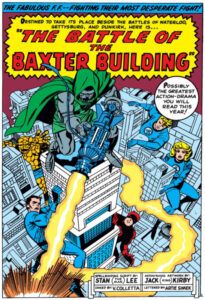 The Battle of the Baxter Building (Fantastic Four #39-40, 1965, written by Stan Lee, art by Jack Kirby): After regaining their powers following an encounter with Daredevil, the Fantastic Four return to the Baxter Building—only to find Doctor Doom waiting for them. Using Reed Richards’ own technology against them, Doom methodically dismantles the team’s defenses, proving himself a master tactician. The story highlights Doom’s cunning and his personal vendetta against Reed, showcasing one of their earliest and most intense battles.
The Battle of the Baxter Building (Fantastic Four #39-40, 1965, written by Stan Lee, art by Jack Kirby): After regaining their powers following an encounter with Daredevil, the Fantastic Four return to the Baxter Building—only to find Doctor Doom waiting for them. Using Reed Richards’ own technology against them, Doom methodically dismantles the team’s defenses, proving himself a master tactician. The story highlights Doom’s cunning and his personal vendetta against Reed, showcasing one of their earliest and most intense battles.- The Bride of Doom (Fantastic Four #32, Nov. 2017, written by Dan Slott, art by R.B. Silva, colors by Jesus Aburtov, letters by Joe Caramanga): In this storyline, Doctor Doom invites the Fantastic Four to his wedding, where he plans to marry Victorious, a powerful Latverian hero and one of his most loyal allies. Confident in his victory over the team, Doom is taken by surprise when Johnny Storm, the Human Torch, shares an intimate night with Victorious, despite his strong bond with Sky, his soulmate from the planet Spyre. This betrayal sends Doom into a violent rage, and the fallout creates a deep rift within the Fantastic Four, further complicating their already tense relationship with the villain. This storyline reveals another layer of Doom’s character—his need for control even in his personal life and the emotional devastation he feels when that control is compromised.
Themes and Impact
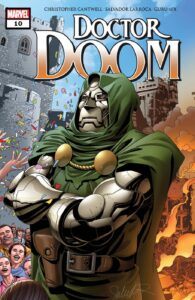 Overconfidence and the Moral Consequences of Unchecked Ambition: A central theme in Doctor Doom’s story is his overwhelming arrogance. His genius intellect often leads him to believe that he is the only one capable of solving the world’s problems, and his relentless pursuit of power blinds him to the consequences of his actions. Doom’s overconfidence drives him to make morally questionable decisions, often at the expense of others, and his rivalry with Reed Richards is a key example of this theme. In This Man… This Monster!, the destructive power of unchecked ambition is evident, as Doom’s desire to prove his superiority leads to irreversible consequences.
Overconfidence and the Moral Consequences of Unchecked Ambition: A central theme in Doctor Doom’s story is his overwhelming arrogance. His genius intellect often leads him to believe that he is the only one capable of solving the world’s problems, and his relentless pursuit of power blinds him to the consequences of his actions. Doom’s overconfidence drives him to make morally questionable decisions, often at the expense of others, and his rivalry with Reed Richards is a key example of this theme. In This Man… This Monster!, the destructive power of unchecked ambition is evident, as Doom’s desire to prove his superiority leads to irreversible consequences.- Exploration of Doom’s Complex Humanity and Tragic Backstory: At the core of Doctor Doom’s character is a deep well of tragedy. Doom’s quest for power is driven by the early loss of his mother and his need to right the wrongs he perceives in the world. His journey is one of both self-destruction and self-discovery, as he seeks control not only over the world but also over his own destiny. Despite his villainous actions, Doom’s humanity shines through in his personal losses and the emotional turmoil he faces. His obsession with control—whether over the world or his relationships—makes him a tragic figure, and his ongoing conflict with the Fantastic Four explores the personal cost of his ambition.
As an Amazon Associate, I earn from qualifying purchases.
Purchase today!
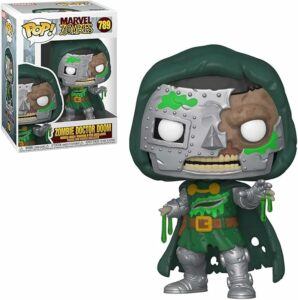
Mole Man: The Rejected Genius Seeking Revenge from Beneath
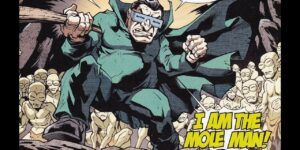
The Mole Man, also known as Harvey Elder, is one of the most iconic and tragic villains in the Marvel Universe. First introduced in Fantastic Four #1 (1961), he is a symbol of societal rejection and an early example of the kinds of adversaries the Fantastic Four would face. As the first Marvel supervillain, the Mole Man set the stage for many of the more complex and varied foes to come. His story is one of isolation, resentment, and a desire for revenge against a world that has never accepted him. While he is often seen as a “classic” villain in the Marvel tradition, his motivations are rooted in his deep emotional pain and sense of alienation, making him a more nuanced character than his appearance might suggest.
Historical Context
- First appearance in Fantastic Four #1 (Fantastic Four #1, Nov. 1961, written by Stan Lee, art by Jack Kirby): The Mole Man’s introduction in Fantastic Four #1 marks the beginning of the Fantastic Four’s long history of facing outlandish threats. As the first villain the team encounters, Mole Man immediately establishes the kind of bizarre challenges the Fantastic Four would have to adapt to, setting the tone for many of their future battles. His motivations stem from a deep-seated anger at being rejected by society and his decision to take control of his destiny beneath the Earth’s surface, leading to his desire to wreak havoc on the surface world.
Key Storylines
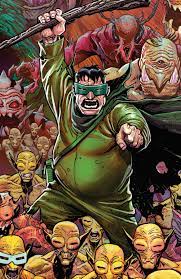 The Mole Man’s Secret (Fantastic Four #1, Nov. 1961, written by Stan Lee, art by Jack Kirby): This storyline introduces Harvey Elder, who becomes the Mole Man. As a rejected scientist, he retreats to the depths of the Earth, where he discovers subterranean creatures. His desire for revenge against the world that spurned him leads him to plot against the surface world. This origin story not only provides a glimpse into Mole Man’s motivations but also explores themes of loneliness, rejection, and the consequences of isolation. The impact of this early tale on the Fantastic Four is significant, as it sets the stage for the team’s moral framework—fighting for justice against those driven by personal pain.
The Mole Man’s Secret (Fantastic Four #1, Nov. 1961, written by Stan Lee, art by Jack Kirby): This storyline introduces Harvey Elder, who becomes the Mole Man. As a rejected scientist, he retreats to the depths of the Earth, where he discovers subterranean creatures. His desire for revenge against the world that spurned him leads him to plot against the surface world. This origin story not only provides a glimpse into Mole Man’s motivations but also explores themes of loneliness, rejection, and the consequences of isolation. The impact of this early tale on the Fantastic Four is significant, as it sets the stage for the team’s moral framework—fighting for justice against those driven by personal pain.- The Return of the Mole Man (Fantastic Four #22, Jan. 1964, written by Stan Lee, art by Jack Kirby): Stranded on a mysterious island after their U-Car sinks, the Fantastic Four pursue a shadowy figure into a cave—only to find their old foe, the Mole Man. Revealing his master plan, he intends to sink New York City and Moscow beneath the Earth, triggering World War III so he can rule the surface.Springing his trap, the Mole Man drops the team into a radioactive energy barrier, preventing escape. As he prepares to activate his device, Sue blocks the trigger with a force field, giving the team time to break free. But the Mole Man counters with traps designed to neutralize their powers. Working together, the Fantastic Four overcome these obstacles, but the Mole Man vanishes into the darkness. As they escape, he triggers his machine—only to realize too late that Reed had rewired it, sinking his own island instead.
Themes and Impact
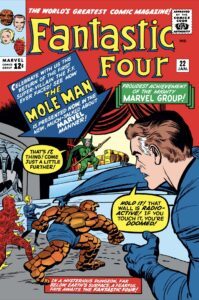 Commentary on Societal Rejection and the Cost of Vengeance: Mole Man’s story is a tragic commentary on the consequences of rejection and the power of isolation. His transformation from a rejected scientist to a villain bent on revenge demonstrates the destructive impact that neglect and mistreatment can have on an individual’s psyche. His desire for vengeance against society echoes a broader commentary on how those who are cast aside by the world can turn their pain into a weapon. Mole Man is a character who represents the dangers of not addressing the emotional and social needs of marginalized individuals.
Commentary on Societal Rejection and the Cost of Vengeance: Mole Man’s story is a tragic commentary on the consequences of rejection and the power of isolation. His transformation from a rejected scientist to a villain bent on revenge demonstrates the destructive impact that neglect and mistreatment can have on an individual’s psyche. His desire for vengeance against society echoes a broader commentary on how those who are cast aside by the world can turn their pain into a weapon. Mole Man is a character who represents the dangers of not addressing the emotional and social needs of marginalized individuals.- Showcasing the Fantastic Four’s Adaptability to Bizarre Challenges: Mole Man’s presence as the first villain the Fantastic Four encounter showcases their ability to confront challenges that are far from typical. The team’s versatility and unique skill sets are tested in battles against the Mole Man’s underground creatures. This story underscores the Fantastic Four’s capacity to adapt to bizarre and otherworldly threats, highlighting their strength as a team. Their ability to overcome Mole Man’s monstrous creations speaks to their unity and resourcefulness in facing the unexpected.
Namor: The Anti-Hero of Atlantis
Namor the Sub-Mariner, is one of Marvel’s earliest and most complex characters, a figure whose deep connections to both the world of superheroes and the mythic world of Atlantis make him an enduring and fascinating part of Marvel’s rich history. Known for his complex morality and anti-hero status, Namor’s character has been central to many critical storylines that examine the tension between loyalty to his people and the complexities of interacting with the surface world.
Purchase this colorful figure today!
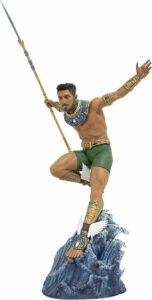
Historical Context
- Origin in Timely Comics (Marvel Comics #1, Oct. 1939, created by Bill Everett): Namor made his first appearance in Marvel Comics #1 back in 1939, making him one of the earliest superheroes in the history of Marvel’s parent company, Timely Comics. His character was created by Bill Everett, who gave him the traits of an anti-hero with a fierce pride in his Atlantean heritage and an often antagonistic stance toward surface dwellers. Namor was one of the first superheroes to explore complex themes like environmentalism and nationalistic loyalty, making him a standout character from the start.
- Resurfacing in Fantastic Four #4 (Fantastic Four #4, May 1962, written by Stan Lee, art by Jack Kirby): After a long hiatus from comic books, Namor resurfaced in Fantastic Four #4 (1962), where he was reintroduced by the legendary duo Stan Lee and Jack Kirby. This story begins with Namor’s return to the surface world, suffering from amnesia, and sets the stage for his role as a recurring antagonist and occasional ally of the Fantastic Four. His rivalry with the team and his complex relationship with their moral framework began to take shape in this issue.
Key Storylines
- The Coming of Sub-Mariner (Fantastic Four #4, May 1962, written by Stan Lee, art by Jack Kirby): Namor’s return to the surface world is marked by his amnesia and initial hostility toward the human race. In this issue, he is portrayed as an anti-hero, torn between his loyalty to Atlantis and his understanding of humanity’s destructive nature. His fight with the Fantastic Four sets the tone for future storylines, where his complex motivations often blur the line between hero and villain. This issue is a defining moment for Namor as he seeks to reconcile his responsibilities to his people with the realities of the surface world.
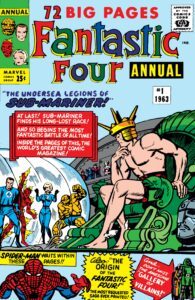 Sub-Mariner Versus the Human Race! (Fantastic Four Annual #1, 1963, written by Stan Lee, art by Jack Kirby): After finally locating his lost kingdom, Namor is joyfully reunited with Lady Dorma, but his return is met with hostility from Warlord Krang. Determined to assert his rule, Namor declares war on the surface world, leading a powerful assault on New York City. His Atlantean forces initially gain the upper hand, but Reed Richards’ ingenuity forces them into retreat.Refusing to accept defeat, Namor confronts the Fantastic Four directly, kidnapping Susan Storm in an attempt to gain leverage. As the battle rages, Krang and Dorma, acting on their own ambitions, attempt to drown Sue. Realizing the depths of their treachery, Namor rescues her and rushes her to a hospital, prioritizing her survival over his war. This selfless act convinces his people that he has betrayed Atlantis, and under Krang’s manipulation, they abandon their sovereign.Left alone once more, Namor returns to the ocean depths—not as a triumphant king, but as an exiled ruler, torn between his love for Atlantis and his complicated ties to the surface world.
Sub-Mariner Versus the Human Race! (Fantastic Four Annual #1, 1963, written by Stan Lee, art by Jack Kirby): After finally locating his lost kingdom, Namor is joyfully reunited with Lady Dorma, but his return is met with hostility from Warlord Krang. Determined to assert his rule, Namor declares war on the surface world, leading a powerful assault on New York City. His Atlantean forces initially gain the upper hand, but Reed Richards’ ingenuity forces them into retreat.Refusing to accept defeat, Namor confronts the Fantastic Four directly, kidnapping Susan Storm in an attempt to gain leverage. As the battle rages, Krang and Dorma, acting on their own ambitions, attempt to drown Sue. Realizing the depths of their treachery, Namor rescues her and rushes her to a hospital, prioritizing her survival over his war. This selfless act convinces his people that he has betrayed Atlantis, and under Krang’s manipulation, they abandon their sovereign.Left alone once more, Namor returns to the ocean depths—not as a triumphant king, but as an exiled ruler, torn between his love for Atlantis and his complicated ties to the surface world.
Themes and Impact
- Exploration of Environmentalism, Loyalty, and Anti-Hero Complexity: Namor is often portrayed as a protector of the oceans and the natural world, which links him to themes of environmentalism. His passionate loyalty to Atlantis, his refusal to fully embrace surface world ideals, and his willingness to take drastic actions to protect his kingdom make him a quintessential anti-hero. His reluctance to fit neatly into the categories of hero or villain challenges traditional comic book archetypes and makes him a compelling figure whose actions are often driven by complex personal motivations rather than simple notions of right or wrong.
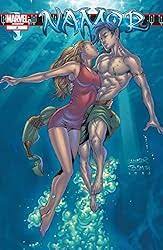 Connection to the Fantastic Four’s Ideals and Flaws: Namor’s interactions with the Fantastic Four reveal the tension between his sense of duty to Atlantis and their more idealistic views. While the Fantastic Four often embody the ideals of heroism, Namor represents a more pragmatic approach to the conflicts that arise between the surface world and Atlantis. This contrast highlights the imperfections and complexities of the Fantastic Four, as Namor’s actions often force the team to question their own motivations and ethics. In this way, Namor serves as a foil to the Fantastic Four, reflecting their flaws and challenging their understanding of what it means to be a hero.
Connection to the Fantastic Four’s Ideals and Flaws: Namor’s interactions with the Fantastic Four reveal the tension between his sense of duty to Atlantis and their more idealistic views. While the Fantastic Four often embody the ideals of heroism, Namor represents a more pragmatic approach to the conflicts that arise between the surface world and Atlantis. This contrast highlights the imperfections and complexities of the Fantastic Four, as Namor’s actions often force the team to question their own motivations and ethics. In this way, Namor serves as a foil to the Fantastic Four, reflecting their flaws and challenging their understanding of what it means to be a hero.
Namor’s rich history and development as a character have made him a mainstay in Marvel comics, offering a nuanced perspective on themes of loyalty, environmentalism, and the challenges of being an anti-hero. His role in the Fantastic Four saga continues to be a compelling aspect of the team’s ongoing struggle with the consequences of their actions, as well as the moral complexities they face in their adventures.
Galactus: Cosmic Threat to Earth and the Universe
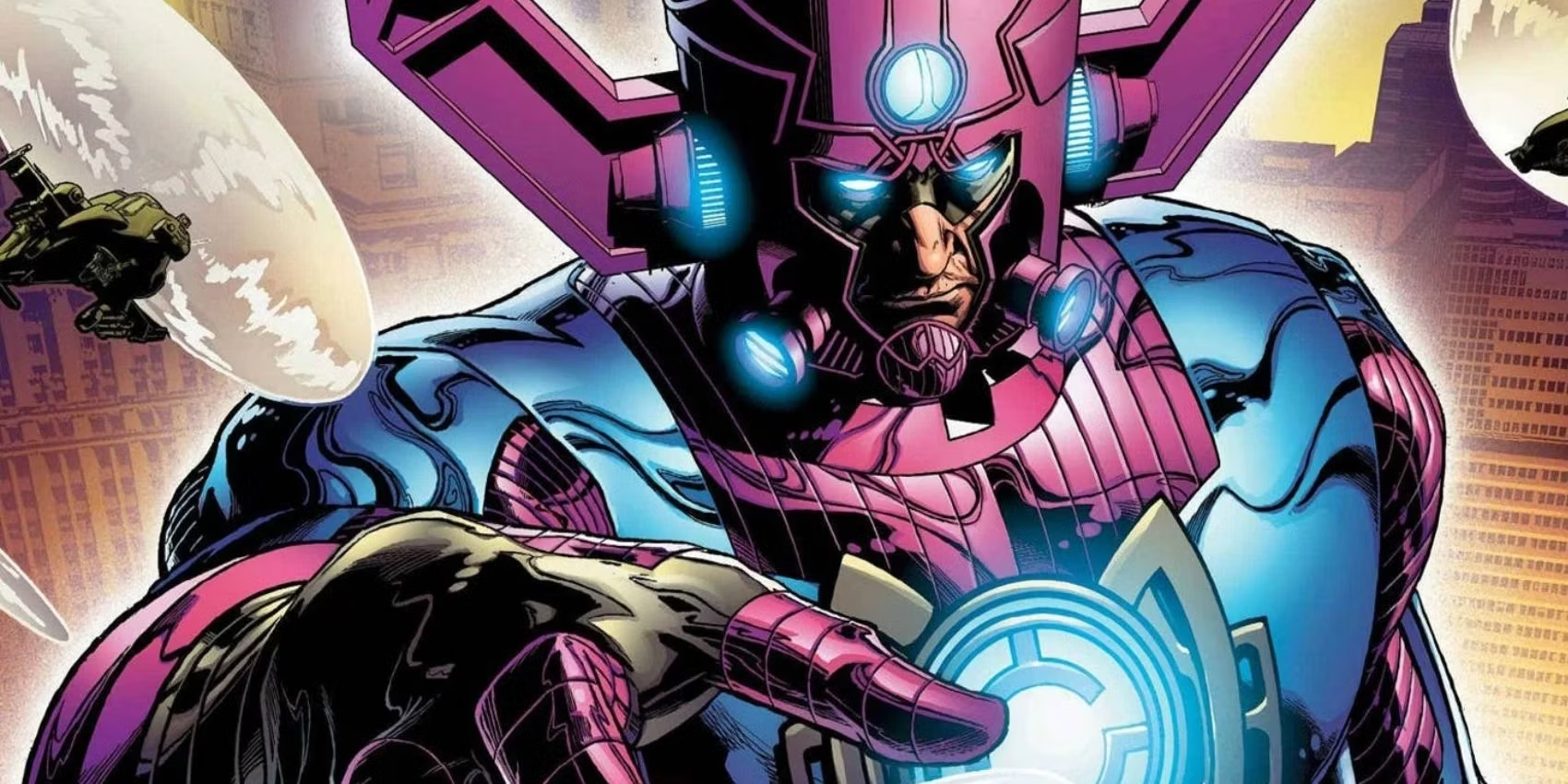
Galactus, the Devourer of Worlds, stands as one of Marvel’s most iconic and morally complex cosmic entities. First introduced in Fantastic Four #48-50 (“The Galactus Trilogy”) in 1966, his arrival on Earth challenged the very fabric of Marvel’s storytelling. As an almost incomprehensible force of nature, Galactus’ presence in the Marvel Universe prompts questions about existence, survival, and morality. His relationship with the Fantastic Four—a mix of antagonist, reluctant ally, and existential threat—has played a pivotal role in defining the team’s cosmic battles.
448 Colorful Pages! Purchase yours today!
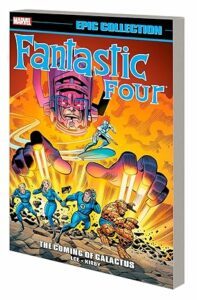
If you are new to Super Hero Collectors, I urge you to check out my previous posts about this cosmic threat: The Devourer of Worlds: Who is Galactus and The Evolution of Galactus in Marvel Comics and Films.
Historical Context
- Introduction in Fantastic Four #48-50 (“The Galactus Trilogy” (Mar.-May 1966, written by Stan Lee, art by Jack Kirby): The first appearance of Galactus sets the stage for one of the most significant cosmic battles in Marvel history. As Galactus comes to Earth with the intent to devour it, the Fantastic Four must confront the overwhelming moral and existential implications of his existence. This marks the beginning of their complex relationship with the cosmic entity.
Key Storylines
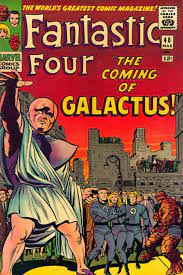 The Galactus Trilogy (Fantastic Four #48-50, Mar.-May 1966): Galactus’ quest to devour Earth brings him into direct conflict with the Fantastic Four. The team’s battle with him showcases the cosmic scale of Marvel’s universe and highlights the moral dilemmas surrounding survival and destruction.
The Galactus Trilogy (Fantastic Four #48-50, Mar.-May 1966): Galactus’ quest to devour Earth brings him into direct conflict with the Fantastic Four. The team’s battle with him showcases the cosmic scale of Marvel’s universe and highlights the moral dilemmas surrounding survival and destruction.- Trial of Reed Richards (Fantastic Four #262, Apr. 1984): Reed Richards defends Galactus’ right to exist in a cosmic trial, challenging the Fantastic Four’s ideals and exposing the philosophical tension between saving Earth and respecting the balance of the universe.
Themes and Impact
- The Devourer as a Force of Nature: Galactus embodies the uncontrollable forces of the universe—an entity whose existence forces other beings to confront their mortality. His constant need to consume entire planets forces the Fantastic Four to question their role in protecting Earth.
- Cosmic Moral Dilemmas: The battles with Galactus push the Fantastic Four into confronting the complexity of cosmic ethics. Should Earth’s survival outweigh the devastation of an entire world? This moral conundrum tests the boundaries of their heroism.
Kang the Conqueror: The Villain Who Defied Time
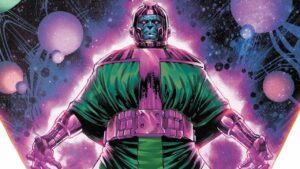
Kang the Conqueror is one of Marvel’s most intriguing and complex villains, with a story that spans across centuries and multiple identities. Known for his manipulation of time, Kang embodies the dangers of unchecked ambition and the consequences of trying to control destiny. His first appearance in Fantastic Four #19 (1963) as Rama-Tut marks the beginning of his long and convoluted timeline, which eventually leads to his most well-known identity as Kang. As Kang, he repeatedly confronts the Fantastic Four, Avengers, and many others in his quest to dominate time itself. Along the way, his many iterations, including his future identity as Immortus, add layers of complexity to his character, making him both a tragic figure and a relentless antagonist.
For a more in-depth look at Kang’s intricate history and his role in both the comics and the Marvel Cinematic Universe, be sure to check out my earlier post Where Did Kang Come From: Discovering the History of MCU’s “Newest” Villain.
Historical Context
- First appearance as Rama-Tut in Fantastic Four #19 (1963, by Stan Lee and Jack Kirby): Kang first appeared as Rama-Tut, an ancient Egyptian ruler, in Fantastic Four #19 (1963). This early version of Kang was one of his many identities, with his story intertwining with time travel and manipulation. His arrival was marked by his possession of advanced technology, which he used to establish a reign over ancient Egypt. However, his story would quickly evolve beyond this time period, leading to his appearance as Kang the Conqueror and later Immortus, a being who oversees the flow of time.
- Later appearances as Kang and Immortus in Avengers-related storylines: As Kang’s story unfolded, his role in the Marvel Universe expanded beyond the Fantastic Four to include pivotal moments in Avengers comics. His identity as Kang the Conqueror, a time-traveling warlord, became central to many of the Avengers’ most important battles. Kang’s role as Immortus, the future version of himself, introduced even deeper questions about fate and destiny. His manipulation of time and the consequences it had for the multiverse became key themes in his storylines, particularly in his appearances in Avengers comics.
Key Storylines
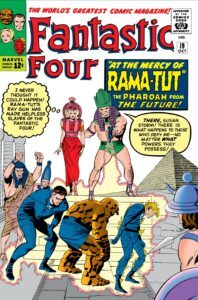 Kang vs. the Fantastic Four (Fantastic Four #19-23, 1963, written by Stan Lee, art by Jack Kirby): In this series of issues, the Fantastic Four face off against Kang, who has traveled through time in an attempt to conquer the present. Kang’s manipulation of time is a major source of tension, as he attempts to alter the past and future to suit his needs. These early issues explore Kang’s fascination with time travel and his belief that he is destined to rule. The story is a clash of idealism versus fate, as the Fantastic Four try to protect the timeline while Kang seeks to bend it to his will.
Kang vs. the Fantastic Four (Fantastic Four #19-23, 1963, written by Stan Lee, art by Jack Kirby): In this series of issues, the Fantastic Four face off against Kang, who has traveled through time in an attempt to conquer the present. Kang’s manipulation of time is a major source of tension, as he attempts to alter the past and future to suit his needs. These early issues explore Kang’s fascination with time travel and his belief that he is destined to rule. The story is a clash of idealism versus fate, as the Fantastic Four try to protect the timeline while Kang seeks to bend it to his will.- The Kang Dynasty (Avengers #41-55, 2001, written by Kurt Busiek, art by several artists including Alan Davis, Kieron Dwyer, Ivan Reis and Manuel Garcia): This storyline shows Kang at his most powerful and dangerous. He assembles an army and launches a full-scale assault on Earth, claiming that his actions are part of his destiny as ruler of time. Kang’s desire for domination is explored through his view of time as a malleable force, one that can be reshaped to meet his desires. This arc delves into the consequences of Kang’s manipulation of time and the moral implications of his quest for control over history. The Avengers must stop Kang not only from conquering Earth but also from warping time itself.
Themes and Impact
- The Dangers of Manipulating Time: Kang’s stories serve as a cautionary tale about the dangers of manipulating time. His repeated attempts to alter history—whether to prevent his own downfall or to create a future where he rules—highlight the catastrophic consequences of such actions. Time manipulation, in Kang’s case, leads to endless paradoxes and the creation of alternate realities, each with its own set of problems. His manipulation of time also reflects a deeper philosophical question: can one truly escape fate, or does the very act of trying to change the future lead to its inevitability?
- Reflection on Power, Legacy, and Destiny: Kang’s quest for power is intrinsically tied to his understanding of his own legacy. As a man from the future, he seeks to conquer the past in order to shape the future in his image. His complex relationship with time—especially his eventual transformation into Immortus, the custodian of time—reflects his struggle to come to terms with his role in the multiverse. Kang’s story is one of ambition, but also one of tragedy, as his efforts to control time lead him to confront the reality of his own inevitable future. His legacy is one of both conquest and loss, and his destiny remains a constant source of conflict, not just with the Fantastic Four and Avengers, but with himself.
The Puppet Master: Master of Control and Deception
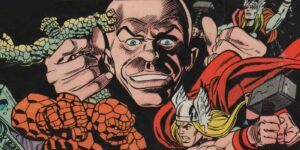
The Puppet Master, made his first appearance in Fantastic Four #8 (1962), created by the legendary duo Stan Lee and Jack Kirby. While not as well-known as other adversaries like Doctor Doom or Galactus, the Puppet Master’s manipulative powers, and psychological tactics have made him a memorable antagonist in the early days of the Fantastic Four saga.
Historical Context
Introduced in Fantastic Four #8 (Sept. 1962), the Puppet Master (Phillip Masters) quickly became one of the Fantastic Four’s most dangerous foes, but not due to physical strength. Instead, his power lay in his ability to control the minds and actions of others using a unique form of manipulation. The key to his sinister abilities came from a piece of a space station struck by cosmic rays, which fell to Earth and infused his clay with the power to control human beings.
Masters, once a brilliant sculptor, discovered that this radioactive clay could animate inanimate objects and even take control of people’s minds. With this new power, he was able to create lifelike puppets out of ordinary people, bending them to his will. His mastery over both clay and his victims made him a formidable threat, one that could disrupt the Fantastic Four not through sheer force, but through cunning psychological manipulation. The Puppet Master’s descent into villainy began after a tragic accident left him disfigured, pushing him to use his abilities for criminal purposes rather than artistic expression.
Key Storylines
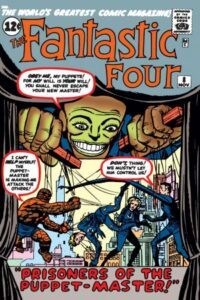 Prisoners of the Puppet Master (Fantastic Four #8, Sept. 1962, written by Stan Lee, art by Jack Kirby): In his first appearance, the Puppet Master manipulates his stepdaughter, Alicia Masters, into assisting him with his scheme against the Fantastic Four. Alicia, a blind sculptress, follows him out of obedience as her stepfather. However, when she encounters the Thing and feels his gentle nature beneath his monstrous exterior, she begins to question her loyalty. Moved by Ben’s kindness, Alicia ultimately turns against the Puppet Master, aiding the Fantastic Four and marking the start of her deep emotional bond with Ben.
Prisoners of the Puppet Master (Fantastic Four #8, Sept. 1962, written by Stan Lee, art by Jack Kirby): In his first appearance, the Puppet Master manipulates his stepdaughter, Alicia Masters, into assisting him with his scheme against the Fantastic Four. Alicia, a blind sculptress, follows him out of obedience as her stepfather. However, when she encounters the Thing and feels his gentle nature beneath his monstrous exterior, she begins to question her loyalty. Moved by Ben’s kindness, Alicia ultimately turns against the Puppet Master, aiding the Fantastic Four and marking the start of her deep emotional bond with Ben.- Terror in a Tiny Town (Fantastic Four Vol. 1 #236, Nov. 1981, written and art by John Byrne): In this issue, the Puppet Master demonstrates his manipulative genius by controlling Doctor Doom to further his schemes against the Fantastic Four. His ability to control powerful figures, not only heroes like Iron Man and Hulk but also villains like Doctor Doom and Namor, shows the extent of his psychological reach. This storyline emphasizes that the Puppet Master’s true strength lies in his ability to exploit the weaknesses and desires of those around him, whether they are allies or adversaries. By manipulating such a wide range of characters, he proves himself a unique and dangerous adversary who uses cunning and psychological manipulation rather than brute force to achieve his goals.
Themes and Impact
- Free Will versus Control: One of the key themes explored through the Puppet Master’s appearances is the tension between free will and control. The characters he manipulates, especially Alicia, are forced to struggle with the loss of their autonomy, reflecting the broader question of whether one can ever truly control their destiny in the face of external forces. This philosophical exploration adds depth to the narratives in which the Puppet Master appears, forcing both the team and the reader to consider the ethics of manipulation and the psychological toll it takes on the manipulated.
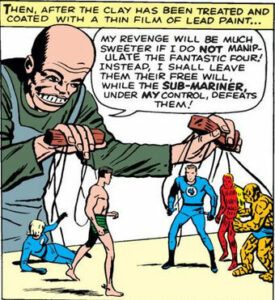 Emotional Depth Through Alicia Masters’ Relationships: The Puppet Master’s influence over Alicia Masters is a pivotal part of his characterization. Alicia’s emotional turmoil, caught between her love for Ben Grimm and the forced loyalty to her step-father, provides emotional depth to the storylines in which the villain appears. His control over Alicia acts as a mirror to Ben’s own internal conflict, as he struggles with feelings of inadequacy and the fear of losing Alicia. This dynamic makes the Puppet Master not just a physical threat, but an emotional one as well, highlighting the vulnerabilities of the Fantastic Four team, especially the core relationship between Ben and Alicia.
Emotional Depth Through Alicia Masters’ Relationships: The Puppet Master’s influence over Alicia Masters is a pivotal part of his characterization. Alicia’s emotional turmoil, caught between her love for Ben Grimm and the forced loyalty to her step-father, provides emotional depth to the storylines in which the villain appears. His control over Alicia acts as a mirror to Ben’s own internal conflict, as he struggles with feelings of inadequacy and the fear of losing Alicia. This dynamic makes the Puppet Master not just a physical threat, but an emotional one as well, highlighting the vulnerabilities of the Fantastic Four team, especially the core relationship between Ben and Alicia.
The Puppet Master’s manipulative nature and his psychological warfare distinguish him from the usual villains who rely on sheer power. His role in the early Fantastic Four issues helped to expand the types of challenges the team faced, from not just physical confrontations but emotional and intellectual battles as well. His storylines explore complex themes of control, autonomy, and personal responsibility, setting him apart from the more straightforward, power-driven adversaries of the time.
Other Notable Villains
While the Fantastic Four face off against some of the most iconic and powerful villains in Marvel history, there are several other adversaries whose roles in the team’s adventures are equally significant. These villains may not always be at the forefront, but their impact is felt throughout the Marvel Universe, offering unique challenges that the Fantastic Four must overcome. Below are brief mentions of a few of these formidable foes.
Annihilus
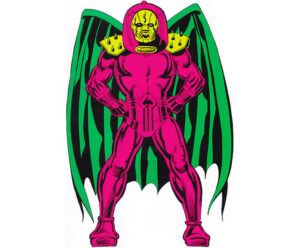 Annihilus, the ruler of the Negative Zone, first appeared in Fantastic Four Annual #6 (1968). With his insectoid appearance and ruthless nature, Annihilus is a constant threat to not just the Fantastic Four, but to the entire universe. His primary goal is to expand his empire and annihilate anything that stands in his way, and his weapon of choice, the Cosmic Control Rod, gives him the power to manipulate energy and destroy entire worlds. Annihilus’ nihilistic view of the universe makes him a formidable foe, as he sees everything, including life itself, as expendable. His presence in the Negative Zone also brings the Fantastic Four face-to-face with the concept of alternate dimensions and the fragility of existence itself.
Annihilus, the ruler of the Negative Zone, first appeared in Fantastic Four Annual #6 (1968). With his insectoid appearance and ruthless nature, Annihilus is a constant threat to not just the Fantastic Four, but to the entire universe. His primary goal is to expand his empire and annihilate anything that stands in his way, and his weapon of choice, the Cosmic Control Rod, gives him the power to manipulate energy and destroy entire worlds. Annihilus’ nihilistic view of the universe makes him a formidable foe, as he sees everything, including life itself, as expendable. His presence in the Negative Zone also brings the Fantastic Four face-to-face with the concept of alternate dimensions and the fragility of existence itself.
Annihilus’ character is a stark contrast to the ideals of the Fantastic Four, whose bonds of family and loyalty fuel their actions. His belief in the ultimate destruction of everything makes him the embodiment of entropy, a destructive force that seeks to return everything to nothingness. The Fantastic Four’s battles with Annihilus often emphasize themes of hope, unity, and the will to survive in the face of inevitable destruction.
The Griever
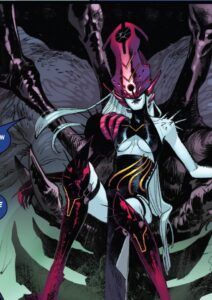 The Griever, introduced in Fantastic Four #1 (2018), represents the embodiment of entropy and ultimate loss. Unlike traditional supervillains driven by power or revenge, The Griever is a more philosophical character, embodying the concept of time’s inevitable decay and the eventual end of all things. As an entity tied to the concept of death and the end of existence, The Griever is both terrifying and tragic, as she is the final force that will bring about the end of the universe.
The Griever, introduced in Fantastic Four #1 (2018), represents the embodiment of entropy and ultimate loss. Unlike traditional supervillains driven by power or revenge, The Griever is a more philosophical character, embodying the concept of time’s inevitable decay and the eventual end of all things. As an entity tied to the concept of death and the end of existence, The Griever is both terrifying and tragic, as she is the final force that will bring about the end of the universe.
The Griever’s battles with the Fantastic Four are not just physical confrontations, but also emotional and existential struggles. She challenges the team’s core belief in family and the preservation of life, forcing them to confront the harsh reality of mortality. Her introduction marks a shift in the kinds of threats the Fantastic Four must face, from external dangers to internal, philosophical dilemmas about the nature of existence and the role of the heroes in an inevitably decaying universe.
The Griever’s impact extends beyond the pages of Fantastic Four comics, as she embodies a more profound and unsettling threat—the knowledge that everything, no matter how powerful, will eventually meet its end. This confrontation is not just a physical one, but an exploration of what it means to fight against forces that cannot be defeated, only endured.
Final Thoughts: The Enemies Who Shaped the Fantastic Four
The battles against these villains have shaped the Fantastic Four in profound ways, helping them grow from a team of adventurers to one of Marvel’s most beloved families. Through their encounters with foes like Doctor Doom, Mole Man, and the Skrulls, the team has become a symbol of resilience, showing that even in the face of overwhelming threats, they remain committed to protecting the world and each other.
These villains are not just obstacles for the Fantastic Four—they embody the themes that have defined Marvel Comics as a whole: the tension between idealism and reality, the cost of overconfidence, and the ever-present danger of unchecked ambition. Through each villain, the Fantastic Four’s journey has been one of self-discovery, growth, and sacrifice.
While this post focused on some of the most iconic villains, we haven’t forgotten about interplanetary threats like the Super Skrull, whose powers and motives make him a uniquely dangerous foe for Marvel’s First Family. But don’t worry—these cosmic and otherworldly adversaries deserve their own spotlight, and a dedicated post on villains from across the universe is on the way.
Which Fantastic Four villain do you think left the greatest mark on Marvel history? How would you rank them? Share your thoughts and favorite stories in the comments and don’t forget to share the post on your favorite media!
Check out this video from Rogues’ Gallery! Several villains mentioned here that I didn’t cover. How would you have voted? Let us know in the comments!
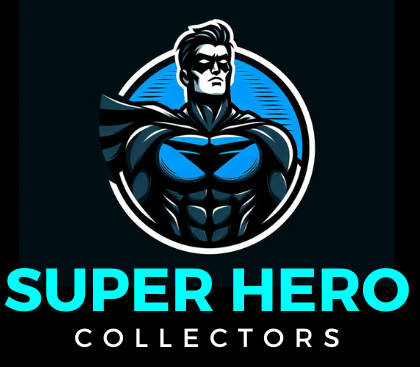
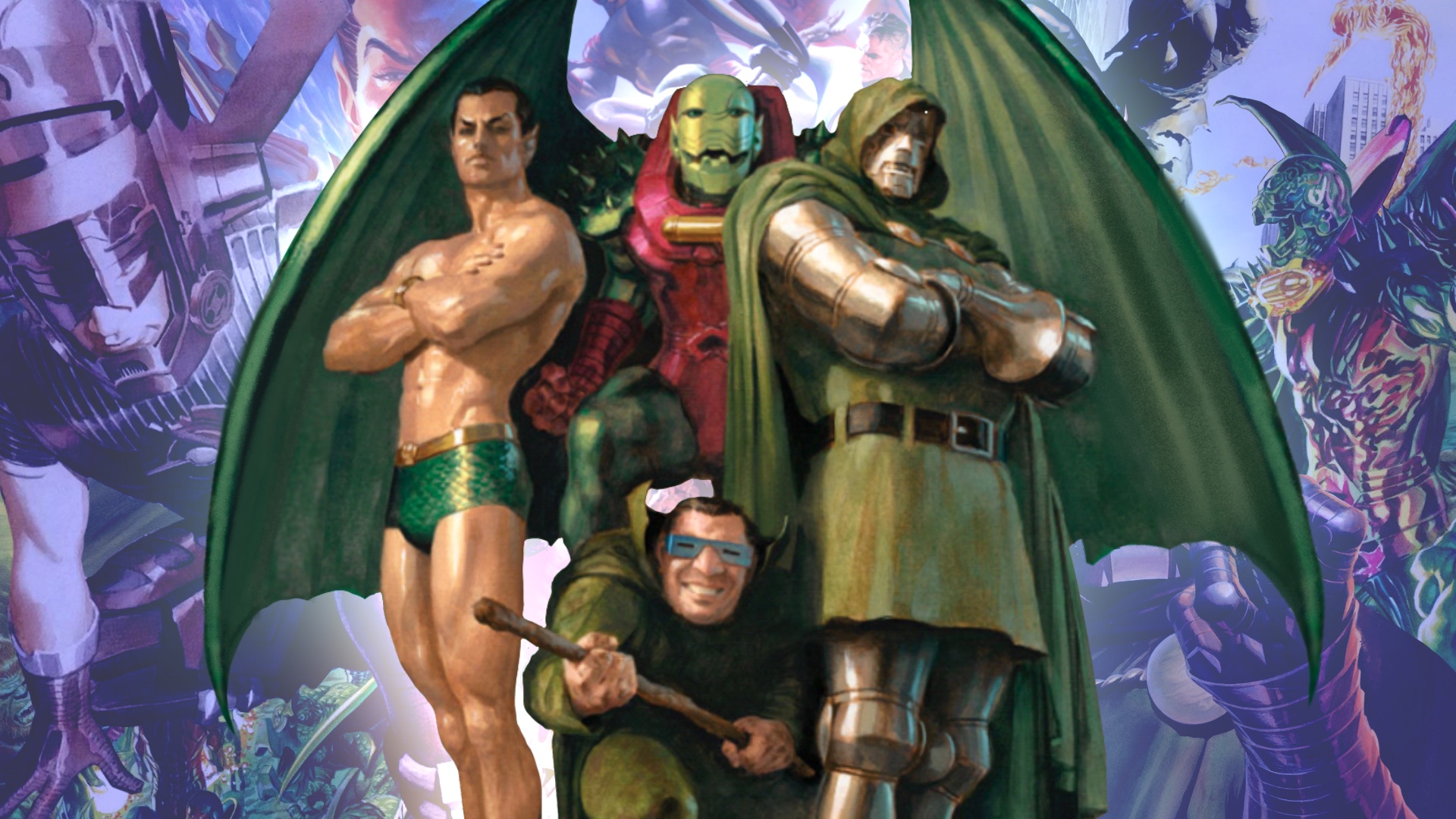
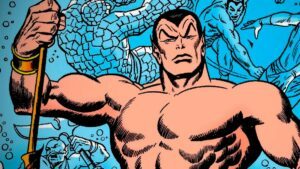
The Fantastic Four’s rogues’ gallery is one of the richest in Marvel history, and this article does a fantastic job of exploring their most iconic villains. Doctor Doom, the team’s ultimate nemesis, remains one of the most compelling characters in comics—his tragic backstory, unmatched intellect, and relentless ambition make him a fascinating antagonist. His battles with Reed Richards aren’t just about physical confrontations; they’re philosophical struggles between unchecked ambition and responsible leadership.
Mole Man’s inclusion as their first-ever villain highlights how the Fantastic Four have always faced challenges that go beyond simple good vs. evil conflicts. His story is one of rejection and bitterness, making him more than just a subterranean conqueror—he’s a symbol of the consequences of alienation.
Namor, on the other hand, is a perfect example of how complex morality can be in comics. His ongoing struggle between his duty to Atlantis and his personal connections to the surface world makes him an unpredictable force in the Marvel Universe.
This article beautifully captures what makes these villains so memorable—each one is not just an obstacle but a reflection of the Fantastic Four’s core themes.
Thank you for your comments. Please continue to come back for superhero fun! And don’t forget to share on social media!
– Scott
Dr Doom is very interesting and complex as a villain. Yes, it’s true that villains are here to make the main characters evolve and push their boundaries as well. I’ve always wondered what pushes villains to become who they are; and you submitted very interesting clues for Dr Doom. The loss of his mother as a child, his need to fix the world to make it in his own image…You also have the fact that Dr Doom is very ambitious and that might also be one of the reason of his downfall. You know, in France, there is the sermon of a very famous bishop called Bossuet who said that when you’re ambitious, you sin as an angel because ambition is common to angelic beings…Maybe that would be food for thought!
Hi!
Thank you for commenting and giving us all something to think about.
Please come back for more superhero fun, and please share with your friends on social media!
– Scott
I enjoyed this.
I used to love the Fantastic Four comics when I was younger and Doctor Doom and Galactus were always up there among my favorites. But to be honest, when they made the jump to cinema, I just could not get into them. I dont know if it was the casting, the way they were written, or just my expectations, but something didnt feel right for me.
Its strange because I love most of the Marvel films in general, but these ones never clicked for me.
Maybe I just need to give them another try because this post reminds me of why I liked them all those years ago.
Do you think any version got them right, or are they just too hard to pull off in live action?
A good post here, and a good website, I will definitely come back again!
Thanks
Chris
HI Chris,
Thank you for your comments and kind words about the post and website!
You are not alone in thinking the FF movies just didn’t get it right. I think it is difficult for a movie to portray our childhood memories in a pleasing way. There was a lot of criticism about the Rise of the Silver Surfer. The portrayal of Galactus was way off, showing him only as a cloud.
I am excited for the new MCU Fantastic Four movie ‘ First Steps. It is coming out this year. I am hopeful that they get Galactus right this time. I am a bit dubious about the gender bend for Silver Surfer, but the jury is still out on that as far as I’m concerned. I think the movie will have more surprises for us, and I can’t wait!
Glad to hear that you will be back. I hope that you can also share my posts on your favorite social media!
– Scott
The article provides a fascinating exploration of the rich history and philosophical depth of the Fantastic Four’s greatest adversary, Doctor Doom. I particularly appreciate how it highlights the intricacies of Doom’s character, especially his blend of genius intellect, ambition, and humanity. The detailed references to key storylines like This Man… This Monster! and The Bride of Doom effectively showcase the complexity of his relationships and the recurring themes of ambition and control. These elements make Doom one of the most compelling villains in Marvel’s universe.
I wonder, among the many dimensions of Doom’s character explored in the comics, which storyline do you think best showcases his humanity and the tragic cost of his ambition?
Thank you, Kavitha! I’m glad you enjoyed the article and appreciated the depth of Doctor Doom’s character. His combination of brilliance, ambition, and personal tragedy makes him one of Marvel’s most compelling figures.
As for a storyline that best showcases Doom’s humanity and the tragic cost of his ambition, Books of Doom by Ed Brubaker is an excellent choice. This retelling of Doom’s origin dives deep into his psyche, showing not just his rise to power but also the personal losses and choices that shaped him. Another standout is Emperor Doom, where Doom actually succeeds in ruling the world, only to realize that absolute power doesn’t bring him fulfillment.
If you have a favorite Doom storyline that resonated with you, I’d love to hear your thoughts! Thanks again for your insightful comment.
– Scott
Thank you very much for reminding me of my childhood. I liked The Fantastic Four but above all, I liked Dr.Doom and Silver Surfer above all, I thank stan Lee for my happy childhood, I used to think my myself as My.fantastic(Reed Richard) that guy is smart next to Tonny Start. I am curious between Mr.Fantastic and Iron name who do you think is more intelligent if you remove the Ironman suit and Mr. Fantastic powers just a straight-up IQ test?
Hi Ravin,
Thank you for your comment! I’m glad this post brought back great memories of your childhood—Stan Lee’s stories have certainly shaped the imaginations of so many fans over the years! Dr. Doom and the Silver Surfer are fantastic choices, each bringing their own unique depth and complexity to the Marvel Universe.
As for your question about intelligence—if we strip away the Iron Man suit and Mr. Fantastic’s stretching powers, it’s a fascinating debate! Both Reed Richards and Tony Stark are considered among the smartest minds in Marvel Comics, but in terms of pure intellect and scientific knowledge, Reed is generally portrayed as the superior genius. His expertise spans multiple fields, including physics, engineering, and biology, and he’s often regarded as the most intelligent human in Marvel. Tony, on the other hand, is a brilliant engineer and strategist, with an unparalleled ability to innovate under pressure. If we’re talking about an IQ test, Reed would likely score higher, but Tony’s ability to think on his feet and apply his intelligence in real-world scenarios makes him just as formidable.
What do you think? Would you still pick Reed as the smartest, or does Tony’s ingenuity change the equation?
Looking forward to your thoughts!
– Scott
This was an incredible deep dive into the Fantastic Four’s greatest villains! Doctor Doom’s complexity and tragic ambition always make him a standout, but I also find Namor’s anti-hero role fascinating. How do you think modern storytelling has evolved these characters over time? Looking forward to your next post on cosmic threats!
Thank you so much, Genie! I’m glad you enjoyed the deep dive into the Fantastic Four’s greatest villains. Doctor Doom’s blend of intellect, sorcery, and personal tragedy definitely makes him one of Marvel’s most compelling characters, while Namor’s shifting loyalties and regal pride add so much depth to his role as both a rival and ally.
Modern storytelling has evolved these characters in fascinating ways. Doom has been portrayed as both a brutal dictator and, at times, a man striving for a higher purpose—his role in Secret Wars (2015), for example, showed him literally reshaping reality in his own image. Namor, on the other hand, has leaned even more into his anti-hero status, especially with his more aggressive stance in Avengers and Invaders storylines. Writers have done a great job of keeping them true to their roots while adding layers of complexity.
I’m excited that you’re looking forward to the next post! Cosmic threats always bring out the best (and worst) in the Fantastic Four, so stay tuned for a deep dive into Galactus, the Silver Surfer, and more! Thanks again for reading and sharing your thoughts!
– Scott
The Fantastic Four’s villains are some of the most fascinating in Marvel’s history because they challenge the team on so many levels—physically, emotionally, and philosophically. Doctor Doom, for instance, isn’t just a genius with a grudge; his tragic backstory and relentless ambition make him a mirror to Reed Richards, exploring themes of control and responsibility. Namor, on the other hand, blurs the line between hero and villain, with his loyalty to Atlantis often clashing with his personal connections to the surface world. Even characters like Mole Man highlight deeper issues, like societal rejection and isolation. These villains aren’t just obstacles—they reflect the complexities of the Fantastic Four’s own dynamics and ideals, making their stories so compelling.
Thanks for your insightful comment, Marco! You’ve perfectly captured what makes the Fantastic Four’s rogues’ gallery so compelling. Their villains aren’t just physical threats—they challenge the team’s ideals, relationships, and even their sense of responsibility. Doom’s rivalry with Reed is one of the greatest examples of how ambition and intellect can take vastly different paths, while Namor’s shifting allegiances constantly test the team’s moral compass. And I love that you mentioned Mole Man—his story is a great example of how rejection and isolation can fuel a villain’s motivations in a deeply human way.
It’s this depth that keeps the Fantastic Four’s stories so engaging, and why these villains remain some of Marvel’s most iconic. Do you have a favorite Fantastic Four villain story that stands out to you? I’d love to hear your thoughts!
– Scott
The Fantastic Four have such a rich history of conflicts, and their villains are some of the most intriguing in comic book lore. Doctor Doom is obviously the most iconic, but I wonder – who among their lesser-known foes do you think deserves more recognition? Characters like Annihilus and Mole Man have had major moments, yet they rarely get the same spotlight. Also, given the evolution of storytelling in comics, how do you think modern interpretations of these villains compare to their classic portrayals? Doom, for example, has gone from a straightforward tyrant to a more complex figure with layers of nobility and tragedy. Would you say this shift has strengthened his role as the Fantastic Four’s ultimate adversary, or does it take away from the pure villainy that made him so legendary?
Thank you for your thoughtful comment, Slavisa! You’re absolutely right—Doctor Doom stands as the Fantastic Four’s most iconic adversary, but many of their lesser-known foes deserve more recognition. Annihilus, for instance, has been a terrifying force in Marvel lore, especially during Annihilation, yet he often remains in the shadow of Doom and Galactus. Mole Man, as the team’s first villain, also set the tone for the kinds of grand-scale threats they would face, but he’s frequently overlooked in modern storytelling. Of course, there are many more villains that have confronted the FF over the decades, such as the Wizard, Psycho Man, Molecular Man, and Diablo. There just isn’t enough room in one post to mention them all. Perhaps I should do another post soon about these bad guys.
As for the evolution of these villains, I think modern interpretations have generally added depth without necessarily diminishing their original menace. Doom is a perfect example—his transformation from a pure megalomaniac to a ruler with a sense of nobility and even a tragic side has made him an even more compelling character. Rather than weakening his villainy, I’d argue it reinforces his status as the Fantastic Four’s greatest adversary. His complexity makes his clashes with Reed Richards all the more profound, since they aren’t just battles of strength, but of ideology, intellect, and even personal grudges.
What are your thoughts on how villains like Annihilus and Mole Man have evolved? Do you think they’ve kept their original appeal, or has modern storytelling altered them too much?
This article provides a compelling overview of the Fantastic Four’s most formidable adversaries, highlighting how each villain uniquely challenges the team’s dynamics and strengths. The detailed exploration of characters like Doctor Doom and Namor offers valuable insights into their complex relationships with Marvel’s First Family. I’m curious, how have these antagonists evolved in their motivations and tactics over the years, and what impact has this had on the Fantastic Four’s development as a team?
Thank you, Hanna! I appreciate your thoughtful feedback on the article. Doctor Doom and Namor, in particular, have undergone fascinating evolutions over the decades. Doom has shifted from a purely power-hungry monarch to a more nuanced figure, sometimes even playing the role of an uneasy ally or antihero, as seen in Infamous Iron Man. You might find it interesting that due to unforeseen circumstances, Dr. Doom was present at the birth of the Richard’s daughter and delivered her. He also was the one who gave her the name Valeria. Namor’s motivations have also fluctuated, from vengeful conqueror to reluctant hero, reflecting his deep internal struggle between his duty to Atlantis and his personal ties to the surface world.
These evolving motivations have forced the Fantastic Four to grow as well. Their early battles often framed them as straightforward defenders of Earth, but over time, they’ve had to navigate moral gray areas, making alliances with former enemies and questioning their own ideals. Doom’s intelligence and Namor’s regal arrogance constantly challenge Reed’s leadership and the team’s unity, adding depth to their character arcs.
Do you have a favorite storyline where one of these villains’ evolving motives really stood out to you? I’d love to hear your thoughts!
I have watched everyone of Fantaastic Four Movies. Each move is based on regular books or comic books like this one. I started collecting comic books for my grandson and look for these. do you know where I can find the Fantastic Four Comic books? I really enjoyed reading your blog post about Fantastic Four and will share.
Hi Marty,
Thanks for reading and for your kind words! I’m glad you enjoyed the post. That’s awesome that you’ve watched all the Fantastic Four movies and are collecting comics for your grandson—what a great way to share your love for superheroes!
I have been enjoying reading the Masterworks collections and omnibus collections of Marvel comics. Here is one that you can start with on affiliate link. This collection is 250 colorful pages of the classic Fantastic Four, Marvel’s first superheroes! Your grandson will enjoy seeing the formation of the FF and their encounter with the Mole Man and other villains!
The Fantastic Four 1 (Marvel Masterworks: The Fantastic Four)
I appreciate that you will share my post!
Please come back for more superhero fun!
– Scott
This was a fantastic deep dive into the villains that have shaped the Fantastic Four’s legacy! Doctor Doom’s complexity, Namor’s moral conflicts, and the sheer cosmic threat of Galactus make for some of the most compelling rivalries in comic book history. I especially appreciate the exploration of their philosophical themes—Doom’s unchecked ambition, Namor’s loyalty struggles, and Kang’s obsession with control really elevate these stories beyond simple hero-villain conflicts. Looking forward to the next post on interplanetary threats like the Super Skrull! Which Fantastic Four villain do you think has had the biggest impact on the Marvel Universe overall?
Thank you, RudaBj! I really appreciate your thoughtful comment. The Fantastic Four’s rogues’ gallery is truly one of the richest in comics, and their villains often bring more than just brute force—they challenge the team’s ideals and push them to evolve. I’m glad you enjoyed the philosophical angle, as that’s something I love exploring in these stories.
As for the villain with the biggest impact on the Marvel Universe overall, it’s hard to argue against Doctor Doom. His influence extends far beyond the Fantastic Four, shaping major events like Secret Wars and The Infinity Gauntlet, and his intellect and ambition put him on par with cosmic entities at times. That said, Galactus literally reshaped the cosmic landscape, and Kang’s time-manipulating schemes ripple across history. Each brings something unique to Marvel’s overarching narrative.
Looking forward to diving into the Super Skrull and other interplanetary threats in the next post! Who’s your favorite Fantastic Four villain?
– Scott
Hi!
Whqt an electrifying wave into the Fantastic Four’s rogue gallery! This article masterfully showcases how these villains aren’t just foes. They’re catalysts for the team’s greatest moments. A thrilling mix of history, conflict, and cosmic chaos, proving once again that the FF’s battles are as much about family as they are about fists and flames! 🔥🦸♂️✨
Wow
Fleeky
Hi,
Thank you for stopping by and leaving a comment. Come back again for more superhero fun!
– Scott
Your article really resonated with me as it explored the Fantastic Four’s greatest villains in such a thoughtful way. I loved how you highlighted the unique legacies of each adversary and the complex dynamics they share with Marvel’s First Family. Doctor Doom’s role as their ultimate nemesis is indeed significant, but I also found it fascinating that you included Annihilus and the other cosmic threats they encounter. It’s so compelling to see how these villains challenge the team not just in physical confrontations but also on deeper emotional and philosophical levels. I truly hope that we can see a follow-up that reflects on how these rivalries have evolved in modern Marvel comics—
Thank you, Kevin! I really appreciate your thoughtful comment. The Fantastic Four’s villains are some of the most dynamic in Marvel, and it’s great to hear that you enjoyed the deeper exploration of their legacies and impact on the team. Doctor Doom is certainly their quintessential nemesis, but I agree—cosmic threats like Annihilus bring a whole different level of danger and storytelling depth.
Your suggestion for a follow-up on how these rivalries have evolved in modern Marvel comics is a fantastic idea! I’m in the middle of a series for the Fantastic Four right now. I never realized before that there is so much to write about! The landscape of the Fantastic Four’s conflicts has certainly changed over time, and I’d love to dive into how recent stories have reshaped these relationships. Thanks again for reading, and I hope you’ll stay tuned for more and share on your favorite social media platform!
– Scott
What I like about this well laid out blog, is how you clearly describe the subject, which for someone like me who came across the blog and hadn’t heard of them before, would give me at least a brief minds eye idea of what I was reading about.
Being honest, Its not something I had heard of before, so I am guessing that this is a hobby of yours, set to words.
I like the SM sharing buttons so you can get leverage from others like me who feel like sharing the article. obviously leveraged traffic is a good type to get because it is organic
I enjoyed reading it and can see that you would attract your target market this way.
HI Dave – I hope you enjoyed your introduction into the Marvel Comics world of the Fantastic Four. I do enjoy reading about the superheroes and watching movies about them. There will be a new movie about the Fantastic Four this year called The Fantastic Four: First Steps.
This blog was my 2nd in a series about this superhero family. Perhaps you would like reading my first post here: Marvel’s First Family: The Origins And Rise Of The Fantastic Four.
Please come back for more superhero fun!
– Scott
Great post! The Fantastic Four’s villains have always been some of the most fascinating characters in the Marvel universe. Doctor Doom, in particular, stands out to me with his deep complexity—his mix of genius and tragedy makes him so much more than a typical antagonist. I’ve always found his philosophical battles with Reed Richards just as engaging as their physical confrontations.
I remember reading The Galactus Trilogy and being blown away by the scale of the threat Galactus posed. It really shifted my perspective on what superhero stories could be—more than just good versus evil, it was about survival, morality, and cosmic balance.
What’s your take on how Kang the Conqueror compares to Doctor Doom? Both are masters of manipulation and ambition, but their motivations feel so different. Would love to hear others’ thoughts!
Thanks, Herman! I couldn’t agree more—Doctor Doom’s depth as a character is what makes him one of the greatest villains in all of comics. His philosophical battles with Reed are just as gripping as their physical ones, and his mix of brilliance, arrogance, and tragedy gives him a presence that few can match.
The Galactus Trilogy is an absolute classic! It really redefined the scope of superhero storytelling, elevating the Fantastic Four’s adventures to a cosmic scale. The moral dilemmas surrounding Galactus and the Silver Surfer added layers of depth that went beyond the usual hero vs. villain dynamic.
As for Kang vs. Doom, that’s a fantastic question. While both are brilliant strategists and masters of manipulation, their motivations set them apart. Doom’s drive comes from his belief in his own superiority—he sees himself as the only one capable of ruling the world justly. Kang, on the other hand, is a conqueror shaped by time itself, obsessed with proving his dominance across different eras. Doom wants to rule, Kang wants to cement his legacy across time. Their clashes with the Fantastic Four are always compelling because they challenge the team in completely different ways.
Would love to hear what others think, too! Who do you find more fascinating—Doom or Kang?
– Scott
Great breakdown of the Fantastic Four’s biggest foes! Doctor Doom is an obvious legend, but I love how deep their villain roster goes. Some of these characters don’t get enough credit for how much they’ve shaped the team’s storylines. Which villain do you think deserves a bigger spotlight in future adaptations?
Thanks for the great comment, Randi! Doctor Doom definitely stands as one of the all-time greatest villains, but I agree, some of the others don’t always get the recognition they deserve. In terms of future adaptations, I’d love to see a deeper exploration of characters like Namor, especially with his complex mix of heroism and antagonism. His storylines really highlight some unique moral dilemmas and offer a rich backdrop for future films. Another character that could use a bigger spotlight is the Puppet Master. His connection with Alicia Masters and his ability to control others makes him a fascinating figure who could bring a lot of tension and drama to the team’s dynamic. What do you think—any villains you’d like to see get more screen time?
– Scott
Your article offers a comprehensive and engaging exploration of the Fantastic Four’s most formidable adversaries. By delving into the complex motivations and backgrounds of villains like Doctor Doom, Galactus, and Namor the Sub-Mariner, it highlights how these antagonists have been instrumental in shaping the narrative and development of Marvel’s First Family. The analysis underscores the intricate interplay between heroism and villainy, emphasizing that the depth of these characters adds significant richness to the overarching storylines. The inclusion of both well-known and perhaps lesser-discussed villains provides a balanced perspective, making it a valuable read for both longtime fans and newcomers interested in understanding the legacy of conflict that defines the Fantastic Four’s journey.
HI JealousLI,
Thank you for stopping in and leaving a comment. Please come back again for more superhero fun!
– Scott
This post really delves into the essence of what makes the Fantastic Four’s villains so compelling. Doctor Doom, with his tragic backstory and relentless ambition, remains a standout character. His complex relationship with Reed Richards adds a layer of depth to their confrontations, making each encounter more than just a battle of good versus evil.
I’m fascinated by how Marvel crafts these villains with such rich histories and motivations. For instance, Mole Man’s story of societal rejection and Namor’s anti-hero complexities provide a nuanced take on what drives them. It’s not just about their powers, but their personal struggles and moral dilemmas that make them memorable.
Personally, I believe Galactus stands out the most. His sheer scale and the existential questions he brings to the table are unparalleled. The “Galactus Trilogy” was a game-changer in comic storytelling, introducing a cosmic threat that challenged the very fabric of the Marvel Universe.
How about you? Which Fantastic Four villain do you think left the greatest mark on Marvel history? I’d love to hear how others rank them and their favorite villain story arcs.
HI Alice,
Thank you for reading and leaving a comment. Some of our readers have answered your question. I hope you take a look at what they have to say.
Please come back for more superhero fun.
– Scott
Scott, absolutely love the site and Marvel. Sadly I’ve never watched the older era – didn’t know it existed in the 60’s and 70’s. Will certainly be having a look and following your site. Also, thanks for the ideas for presents for my kids – appreciated. Lastly, do you think the older Marvel is better than the modern?
Thanks
Peter
Hi Peter,
Thank you for visiting my site and for the kind words. I’m thrilled that you enjoy it. I hope you find some good Marvel gifts for your kids with the links that I’ve provided. If not, just search around for more ideas while you are there.
Which do I think is better? There are points that I like about them both. I like that the older Marvel is kid friendly. Yes, it is cheesier, but a good fun read for kids, especially Spider-Man and the Avengers. I also love the classic artwork of the older Marvel. The newer Marvel is more realistic in the artwork, and it takes a while to get used to it. Also, there is more rough language and blood in the newer language. They are a pretty rough PG-13, in my opinion, or higher. The stories are more involved in the newer stories, as well.
Please continue to visit my site and share on your favorite social media!
– Scott
Hello. This is a thought-provoking article. The Fantastic Four’s evolution from mere adventurers to Marvel’s First Family is deeply intertwined with their confrontations against formidable adversaries. Doctor Doom, their archenemy, embodies unchecked ambition and the perils of overconfidence, challenging the team both intellectually and morally. Galactus, the Devourer of Worlds, presents existential threats that test their unity and resilience. Encounters with the Skrulls, especially the Super-Skrull, force the team to confront issues of trust and identity. Each villain not only serves as an obstacle but also as a catalyst for the team’s growth, highlighting themes of idealism versus reality and the costs of ambition. Through these battles, the Fantastic Four have become a symbol of perseverance and familial bonds, reinforcing their status as one of Marvel’s most beloved teams.
HI Iris,
Thank you for stopping by and summing up my post.
Come back for my superhero fun.
– Scott
“Fantastic breakdown of the Fantastic Four’s most iconic villains! Doctor Doom, of course, stands out as one of the most complex and tragic characters in Marvel. His blend of brilliance and ambition makes him a compelling adversary, especially in his conflicts with Reed Richards. I particularly appreciate the exploration of his moral and philosophical struggles—it makes him far more than just a typical power-hungry villain. I also love how the article touches on the emotional stakes and deeper themes of family, responsibility, and overconfidence that make these villainous encounters so memorable. Can’t wait to read more about the other villains!”
Thanks so much, Robbie! I really appreciate your kind words and your thoughtful take on Doctor Doom. He truly is one of Marvel’s most layered villains—his intellect, ambition, and deep-seated insecurities make him such a fascinating character to analyze. His rivalry with Reed Richards is one of the most enduring in comics, and their battles always carry those deeper philosophical and emotional undertones.
I’m glad you enjoyed the exploration of the themes like family, responsibility, and overconfidence—those elements are what make the Fantastic Four’s stories stand out from traditional superhero narratives. There’s definitely more to come, including a deeper dive into some of their other major enemies and cosmic threats! Hope you’ll check those out, and I’d love to hear your thoughts on them too.
Thanks again for reading and commenting!
– Scott
Scott,
This is a fantastic exploration of the Fantastic Four’s greatest villains! You’ve really captured the essence of each character, delving into their motivations and the philosophical themes they represent. I particularly enjoyed the deep dive into Doctor Doom’s complex humanity and the examination of Galactus as a force of nature.
I’m curious, considering the evolution of these villains over time, which villain do you think has had the most significant impact on the Fantastic Four’s personal growth and dynamic as a family?
Phil
Hi Phil,
Thank you for your thoughtful comment! I’m really glad you enjoyed the deep dive into the Fantastic Four’s rogues’ gallery—especially Doom and Galactus, as they are some of the most layered antagonists in Marvel Comics.
Your question about which villain has had the most significant impact on the Fantastic Four’s personal growth is a great one. While Doom is undoubtedly their greatest rival, constantly challenging Reed both intellectually and morally, I’d argue that Galactus’ arrival had the most profound effect on their understanding of their place in the universe. Facing Galactus forced them to reckon with powers far beyond their own, shifting their perception of heroism from battling supervillains to confronting cosmic forces that test their very ideals.
That said, I’d also give an honorable mention to Namor. His complicated history with both Sue and the team as a whole introduced deep personal conflicts that reshaped their family dynamic, particularly in the early years.
Who would you say has had the biggest impact on the team’s growth?
Thanks again for reading and engaging!
Best,
Scott
Great read! I love how you highlighted Doom’s mix of science and magic, it’s what makes him such a standout villain. His evolution into a more tragic, complex character is fascinating; it blurs the line between villain and antihero, making him even more compelling.
I also think the Fantastic Four’s villains don’t always get the credit they deserve. Characters like Annihilus and Kang bring such high-stakes threats, yet Doom tends to steal the spotlight. It’ll be interesting to see how the MCU handles these characters, getting their depth right could really define the Fantastic Four’s big-screen legacy. Excited to see where it goes!
Thanks so much, Matteo! I’m really glad you enjoyed the post. You’re spot on about Doom—his blend of science and sorcery, combined with that tragic nobility, makes him one of Marvel’s most layered characters. I love that his motivations are often rooted in a warped sense of duty or honor, which adds so much depth to his story.
And yes, Annihilus and Kang definitely deserve more of the spotlight. Annihilus, with his obsession over survival and control of the Negative Zone, brings such a unique kind of menace. And Kang’s time-traveling schemes ripple across so many eras and teams—it’s wild how much potential he holds for long-form storytelling in the MCU.
I’m right there with you—if Marvel can capture the complexity of these villains on screen, it could elevate the Fantastic Four’s cinematic legacy in a big way. We’re especially looking forward to Fantastic Four: First Steps and how it sets the tone for their future in the MCU!
Thanks again for reading and sharing your thoughts!
– Scott
This post does a great job of exploring the Fantastic Four’s most iconic villains and their lasting impact on the Marvel Universe. Doctor Doom’s rivalry with Reed Richards is legendary, and Galactus’ arrival remains one of the most memorable comic moments. I appreciate the discussion on how these villains have evolved over time. Which villain do you think has had the most lasting effect on the team’s legacy? Great read for any superhero fan! Debra
Hi Debra, thanks so much for your kind words and thoughtful comment! I’m really glad you enjoyed the post. You’re absolutely right—Doctor Doom and Galactus both left enormous marks on the Fantastic Four’s history (and the Marvel Universe as a whole). Doom’s personal vendetta against Reed adds so much depth to their battles, and Galactus forced the team to confront threats on a cosmic scale.
As for which villain has had the most lasting effect—that’s a great question! I’d probably lean toward Doctor Doom, simply because his presence is so personal and persistent. His rivalry with Reed challenges not just their powers but their philosophies, and that tension has shaped so many key storylines. But I’d love to hear what you think—do you have a favorite?
Thanks again for reading and sharing your thoughts! If you haven’t already, feel free to follow our page for more deep dives into Marvel’s most iconic characters and stories—we’d love to have you as part of the Super Hero Collectors community!
– Scott